BSBINN601 - Leading Organizational Change: Australia Post Analysis
VerifiedAdded on 2023/06/11
|57
|12562
|249
Homework Assignment
AI Summary
This BSBINN601 assignment solution provides a comprehensive analysis of leading and managing organizational change, focusing on the strategic change needs of organizations. It emphasizes the importance of analyzing an organization's objectives when identifying change requirements and opportunities. Using the Australia Post case study, the assignment identifies strategic changes driven by factors like the eCommerce boom, contactless services, and increased digital communication due to the pandemic. It also highlights the necessity of reviewing existing policies and practices against strategic objectives to mitigate risks and ensure alignment. The document includes activity checklists for assessors to evaluate the learner's understanding and performance in various aspects of organizational change management. Desklib offers a wide array of such solved assignments and past papers for students.
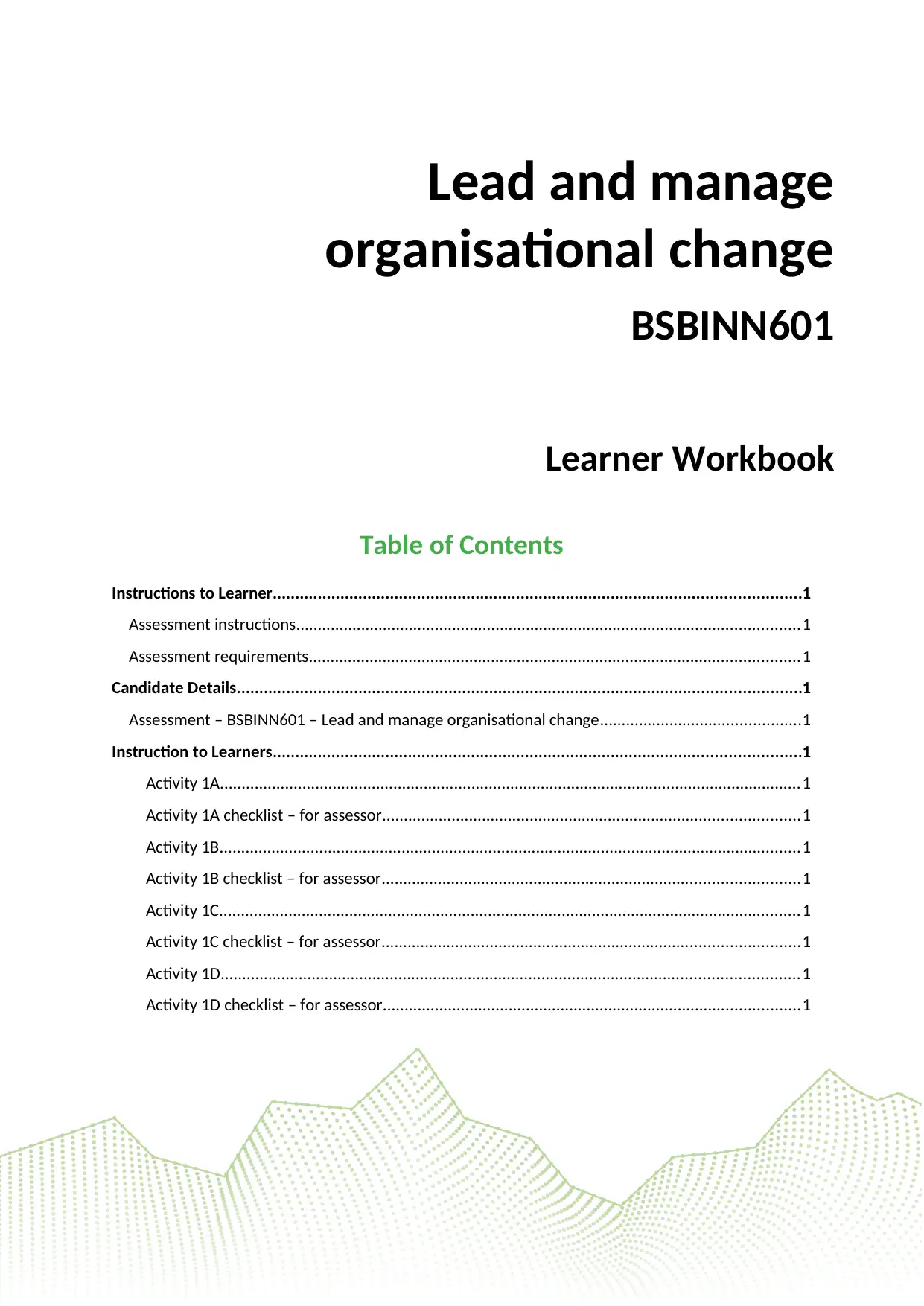
Table of Contents
Instructions to Learner.....................................................................................................................1
Assessment instructions....................................................................................................................1
Assessment requirements.................................................................................................................1
Candidate Details.............................................................................................................................1
Assessment – BSBINN601 – Lead and manage organisational change..............................................1
Instruction to Learners.....................................................................................................................1
Activity 1A......................................................................................................................................1
Activity 1A checklist – for assessor................................................................................................1
Activity 1B......................................................................................................................................1
Activity 1B checklist – for assessor................................................................................................1
Activity 1C......................................................................................................................................1
Activity 1C checklist – for assessor................................................................................................1
Activity 1D.....................................................................................................................................1
Activity 1D checklist – for assessor................................................................................................1
Lead and manage
organisational change
BSBINN601
Learner Workbook
Instructions to Learner.....................................................................................................................1
Assessment instructions....................................................................................................................1
Assessment requirements.................................................................................................................1
Candidate Details.............................................................................................................................1
Assessment – BSBINN601 – Lead and manage organisational change..............................................1
Instruction to Learners.....................................................................................................................1
Activity 1A......................................................................................................................................1
Activity 1A checklist – for assessor................................................................................................1
Activity 1B......................................................................................................................................1
Activity 1B checklist – for assessor................................................................................................1
Activity 1C......................................................................................................................................1
Activity 1C checklist – for assessor................................................................................................1
Activity 1D.....................................................................................................................................1
Activity 1D checklist – for assessor................................................................................................1
Lead and manage
organisational change
BSBINN601
Learner Workbook
Paraphrase This Document
Need a fresh take? Get an instant paraphrase of this document with our AI Paraphraser
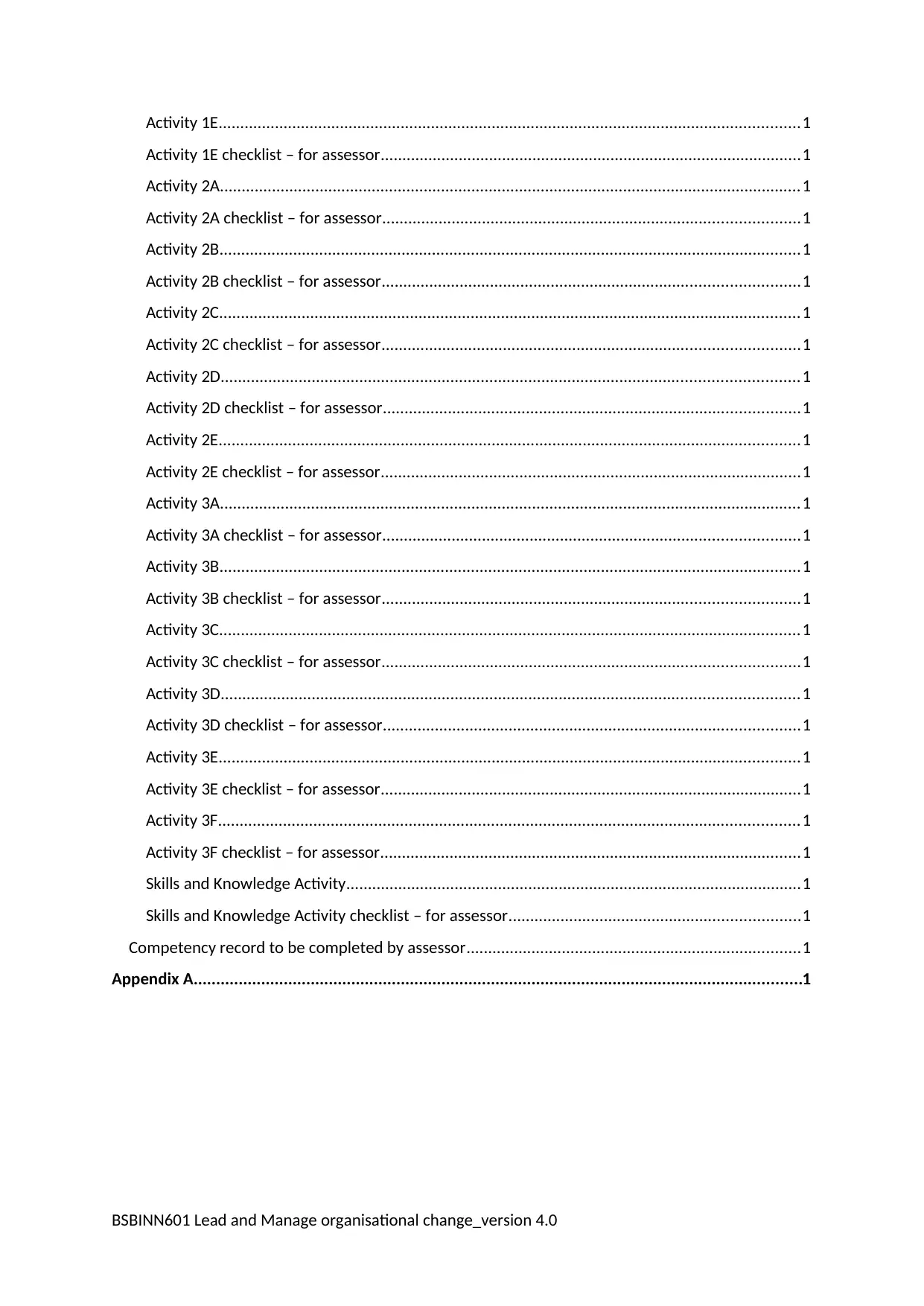
Activity 1E......................................................................................................................................1
Activity 1E checklist – for assessor.................................................................................................1
Activity 2A......................................................................................................................................1
Activity 2A checklist – for assessor................................................................................................1
Activity 2B......................................................................................................................................1
Activity 2B checklist – for assessor................................................................................................1
Activity 2C......................................................................................................................................1
Activity 2C checklist – for assessor................................................................................................1
Activity 2D.....................................................................................................................................1
Activity 2D checklist – for assessor................................................................................................1
Activity 2E......................................................................................................................................1
Activity 2E checklist – for assessor.................................................................................................1
Activity 3A......................................................................................................................................1
Activity 3A checklist – for assessor................................................................................................1
Activity 3B......................................................................................................................................1
Activity 3B checklist – for assessor................................................................................................1
Activity 3C......................................................................................................................................1
Activity 3C checklist – for assessor................................................................................................1
Activity 3D.....................................................................................................................................1
Activity 3D checklist – for assessor................................................................................................1
Activity 3E......................................................................................................................................1
Activity 3E checklist – for assessor.................................................................................................1
Activity 3F......................................................................................................................................1
Activity 3F checklist – for assessor.................................................................................................1
Skills and Knowledge Activity.........................................................................................................1
Skills and Knowledge Activity checklist – for assessor...................................................................1
Competency record to be completed by assessor.............................................................................1
Appendix A.......................................................................................................................................1
BSBINN601 Lead and Manage organisational change_version 4.0
Activity 1E checklist – for assessor.................................................................................................1
Activity 2A......................................................................................................................................1
Activity 2A checklist – for assessor................................................................................................1
Activity 2B......................................................................................................................................1
Activity 2B checklist – for assessor................................................................................................1
Activity 2C......................................................................................................................................1
Activity 2C checklist – for assessor................................................................................................1
Activity 2D.....................................................................................................................................1
Activity 2D checklist – for assessor................................................................................................1
Activity 2E......................................................................................................................................1
Activity 2E checklist – for assessor.................................................................................................1
Activity 3A......................................................................................................................................1
Activity 3A checklist – for assessor................................................................................................1
Activity 3B......................................................................................................................................1
Activity 3B checklist – for assessor................................................................................................1
Activity 3C......................................................................................................................................1
Activity 3C checklist – for assessor................................................................................................1
Activity 3D.....................................................................................................................................1
Activity 3D checklist – for assessor................................................................................................1
Activity 3E......................................................................................................................................1
Activity 3E checklist – for assessor.................................................................................................1
Activity 3F......................................................................................................................................1
Activity 3F checklist – for assessor.................................................................................................1
Skills and Knowledge Activity.........................................................................................................1
Skills and Knowledge Activity checklist – for assessor...................................................................1
Competency record to be completed by assessor.............................................................................1
Appendix A.......................................................................................................................................1
BSBINN601 Lead and Manage organisational change_version 4.0
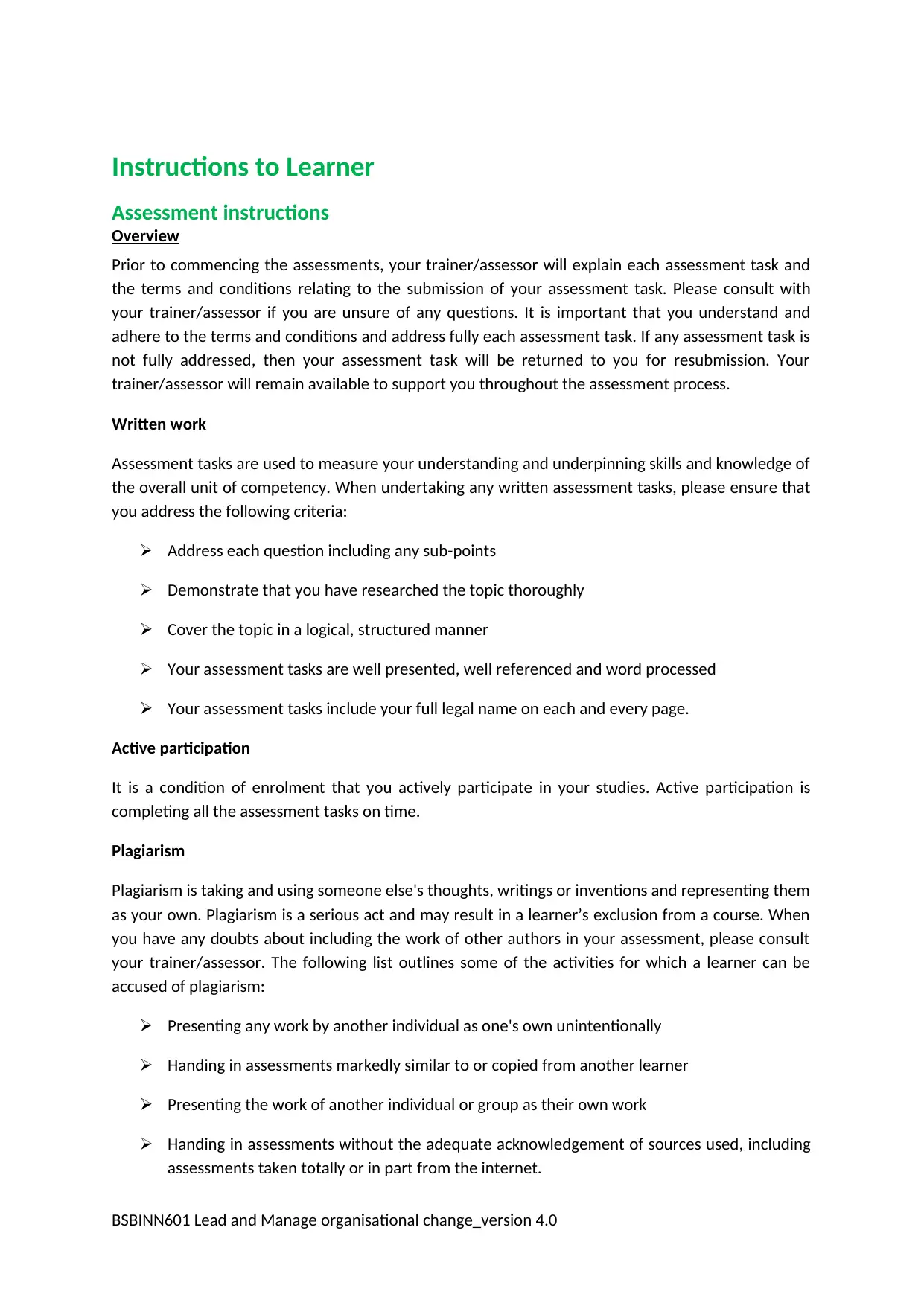
Instructions to Learner
Assessment instructions
Overview
Prior to commencing the assessments, your trainer/assessor will explain each assessment task and
the terms and conditions relating to the submission of your assessment task. Please consult with
your trainer/assessor if you are unsure of any questions. It is important that you understand and
adhere to the terms and conditions and address fully each assessment task. If any assessment task is
not fully addressed, then your assessment task will be returned to you for resubmission. Your
trainer/assessor will remain available to support you throughout the assessment process.
Written work
Assessment tasks are used to measure your understanding and underpinning skills and knowledge of
the overall unit of competency. When undertaking any written assessment tasks, please ensure that
you address the following criteria:
Address each question including any sub-points
Demonstrate that you have researched the topic thoroughly
Cover the topic in a logical, structured manner
Your assessment tasks are well presented, well referenced and word processed
Your assessment tasks include your full legal name on each and every page.
Active participation
It is a condition of enrolment that you actively participate in your studies. Active participation is
completing all the assessment tasks on time.
Plagiarism
Plagiarism is taking and using someone else's thoughts, writings or inventions and representing them
as your own. Plagiarism is a serious act and may result in a learner’s exclusion from a course. When
you have any doubts about including the work of other authors in your assessment, please consult
your trainer/assessor. The following list outlines some of the activities for which a learner can be
accused of plagiarism:
Presenting any work by another individual as one's own unintentionally
Handing in assessments markedly similar to or copied from another learner
Presenting the work of another individual or group as their own work
Handing in assessments without the adequate acknowledgement of sources used, including
assessments taken totally or in part from the internet.
BSBINN601 Lead and Manage organisational change_version 4.0
Assessment instructions
Overview
Prior to commencing the assessments, your trainer/assessor will explain each assessment task and
the terms and conditions relating to the submission of your assessment task. Please consult with
your trainer/assessor if you are unsure of any questions. It is important that you understand and
adhere to the terms and conditions and address fully each assessment task. If any assessment task is
not fully addressed, then your assessment task will be returned to you for resubmission. Your
trainer/assessor will remain available to support you throughout the assessment process.
Written work
Assessment tasks are used to measure your understanding and underpinning skills and knowledge of
the overall unit of competency. When undertaking any written assessment tasks, please ensure that
you address the following criteria:
Address each question including any sub-points
Demonstrate that you have researched the topic thoroughly
Cover the topic in a logical, structured manner
Your assessment tasks are well presented, well referenced and word processed
Your assessment tasks include your full legal name on each and every page.
Active participation
It is a condition of enrolment that you actively participate in your studies. Active participation is
completing all the assessment tasks on time.
Plagiarism
Plagiarism is taking and using someone else's thoughts, writings or inventions and representing them
as your own. Plagiarism is a serious act and may result in a learner’s exclusion from a course. When
you have any doubts about including the work of other authors in your assessment, please consult
your trainer/assessor. The following list outlines some of the activities for which a learner can be
accused of plagiarism:
Presenting any work by another individual as one's own unintentionally
Handing in assessments markedly similar to or copied from another learner
Presenting the work of another individual or group as their own work
Handing in assessments without the adequate acknowledgement of sources used, including
assessments taken totally or in part from the internet.
BSBINN601 Lead and Manage organisational change_version 4.0
⊘ This is a preview!⊘
Do you want full access?
Subscribe today to unlock all pages.

Trusted by 1+ million students worldwide
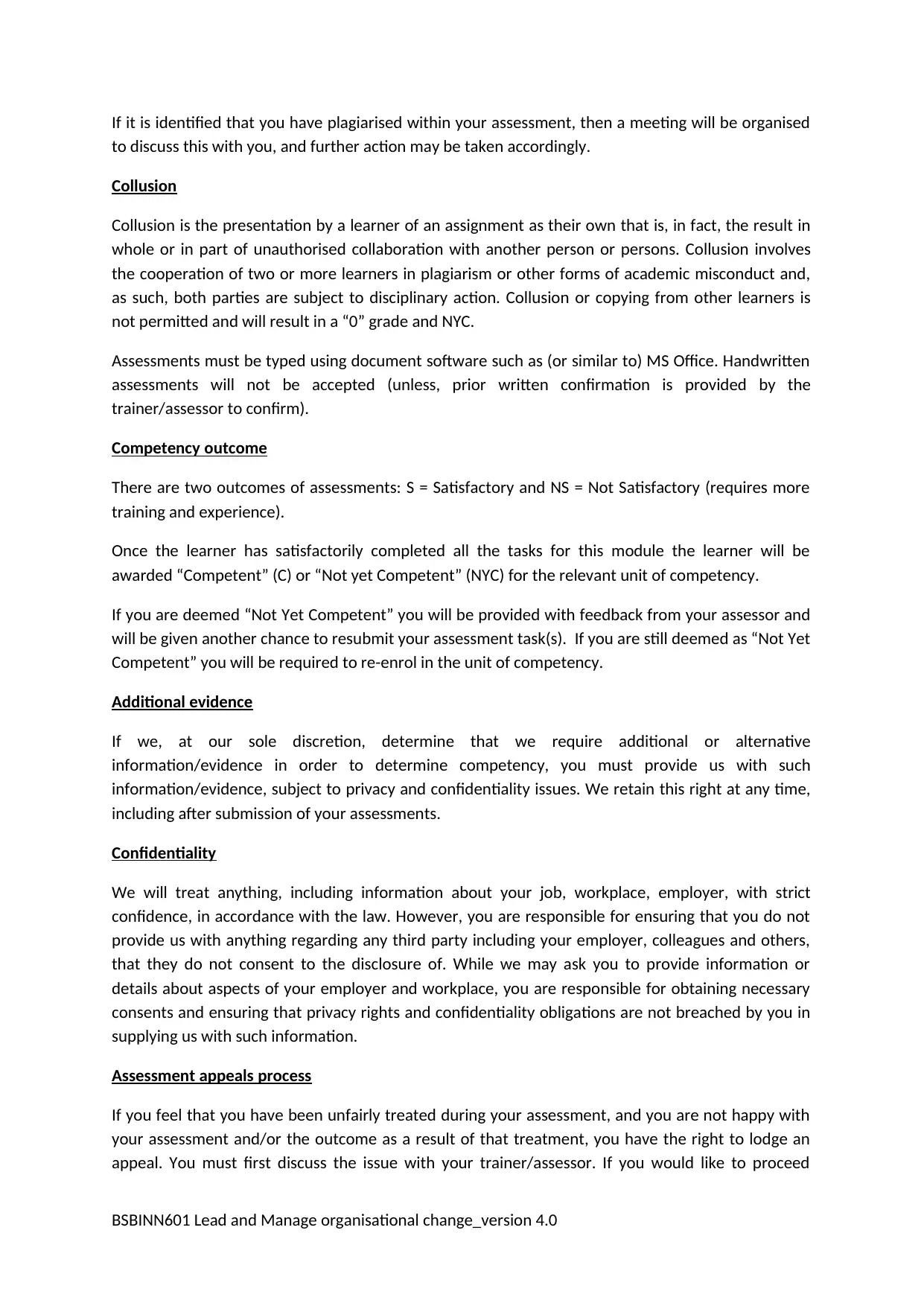
If it is identified that you have plagiarised within your assessment, then a meeting will be organised
to discuss this with you, and further action may be taken accordingly.
Collusion
Collusion is the presentation by a learner of an assignment as their own that is, in fact, the result in
whole or in part of unauthorised collaboration with another person or persons. Collusion involves
the cooperation of two or more learners in plagiarism or other forms of academic misconduct and,
as such, both parties are subject to disciplinary action. Collusion or copying from other learners is
not permitted and will result in a “0” grade and NYC.
Assessments must be typed using document software such as (or similar to) MS Office. Handwritten
assessments will not be accepted (unless, prior written confirmation is provided by the
trainer/assessor to confirm).
Competency outcome
There are two outcomes of assessments: S = Satisfactory and NS = Not Satisfactory (requires more
training and experience).
Once the learner has satisfactorily completed all the tasks for this module the learner will be
awarded “Competent” (C) or “Not yet Competent” (NYC) for the relevant unit of competency.
If you are deemed “Not Yet Competent” you will be provided with feedback from your assessor and
will be given another chance to resubmit your assessment task(s). If you are still deemed as “Not Yet
Competent” you will be required to re-enrol in the unit of competency.
Additional evidence
If we, at our sole discretion, determine that we require additional or alternative
information/evidence in order to determine competency, you must provide us with such
information/evidence, subject to privacy and confidentiality issues. We retain this right at any time,
including after submission of your assessments.
Confidentiality
We will treat anything, including information about your job, workplace, employer, with strict
confidence, in accordance with the law. However, you are responsible for ensuring that you do not
provide us with anything regarding any third party including your employer, colleagues and others,
that they do not consent to the disclosure of. While we may ask you to provide information or
details about aspects of your employer and workplace, you are responsible for obtaining necessary
consents and ensuring that privacy rights and confidentiality obligations are not breached by you in
supplying us with such information.
Assessment appeals process
If you feel that you have been unfairly treated during your assessment, and you are not happy with
your assessment and/or the outcome as a result of that treatment, you have the right to lodge an
appeal. You must first discuss the issue with your trainer/assessor. If you would like to proceed
BSBINN601 Lead and Manage organisational change_version 4.0
to discuss this with you, and further action may be taken accordingly.
Collusion
Collusion is the presentation by a learner of an assignment as their own that is, in fact, the result in
whole or in part of unauthorised collaboration with another person or persons. Collusion involves
the cooperation of two or more learners in plagiarism or other forms of academic misconduct and,
as such, both parties are subject to disciplinary action. Collusion or copying from other learners is
not permitted and will result in a “0” grade and NYC.
Assessments must be typed using document software such as (or similar to) MS Office. Handwritten
assessments will not be accepted (unless, prior written confirmation is provided by the
trainer/assessor to confirm).
Competency outcome
There are two outcomes of assessments: S = Satisfactory and NS = Not Satisfactory (requires more
training and experience).
Once the learner has satisfactorily completed all the tasks for this module the learner will be
awarded “Competent” (C) or “Not yet Competent” (NYC) for the relevant unit of competency.
If you are deemed “Not Yet Competent” you will be provided with feedback from your assessor and
will be given another chance to resubmit your assessment task(s). If you are still deemed as “Not Yet
Competent” you will be required to re-enrol in the unit of competency.
Additional evidence
If we, at our sole discretion, determine that we require additional or alternative
information/evidence in order to determine competency, you must provide us with such
information/evidence, subject to privacy and confidentiality issues. We retain this right at any time,
including after submission of your assessments.
Confidentiality
We will treat anything, including information about your job, workplace, employer, with strict
confidence, in accordance with the law. However, you are responsible for ensuring that you do not
provide us with anything regarding any third party including your employer, colleagues and others,
that they do not consent to the disclosure of. While we may ask you to provide information or
details about aspects of your employer and workplace, you are responsible for obtaining necessary
consents and ensuring that privacy rights and confidentiality obligations are not breached by you in
supplying us with such information.
Assessment appeals process
If you feel that you have been unfairly treated during your assessment, and you are not happy with
your assessment and/or the outcome as a result of that treatment, you have the right to lodge an
appeal. You must first discuss the issue with your trainer/assessor. If you would like to proceed
BSBINN601 Lead and Manage organisational change_version 4.0
Paraphrase This Document
Need a fresh take? Get an instant paraphrase of this document with our AI Paraphraser
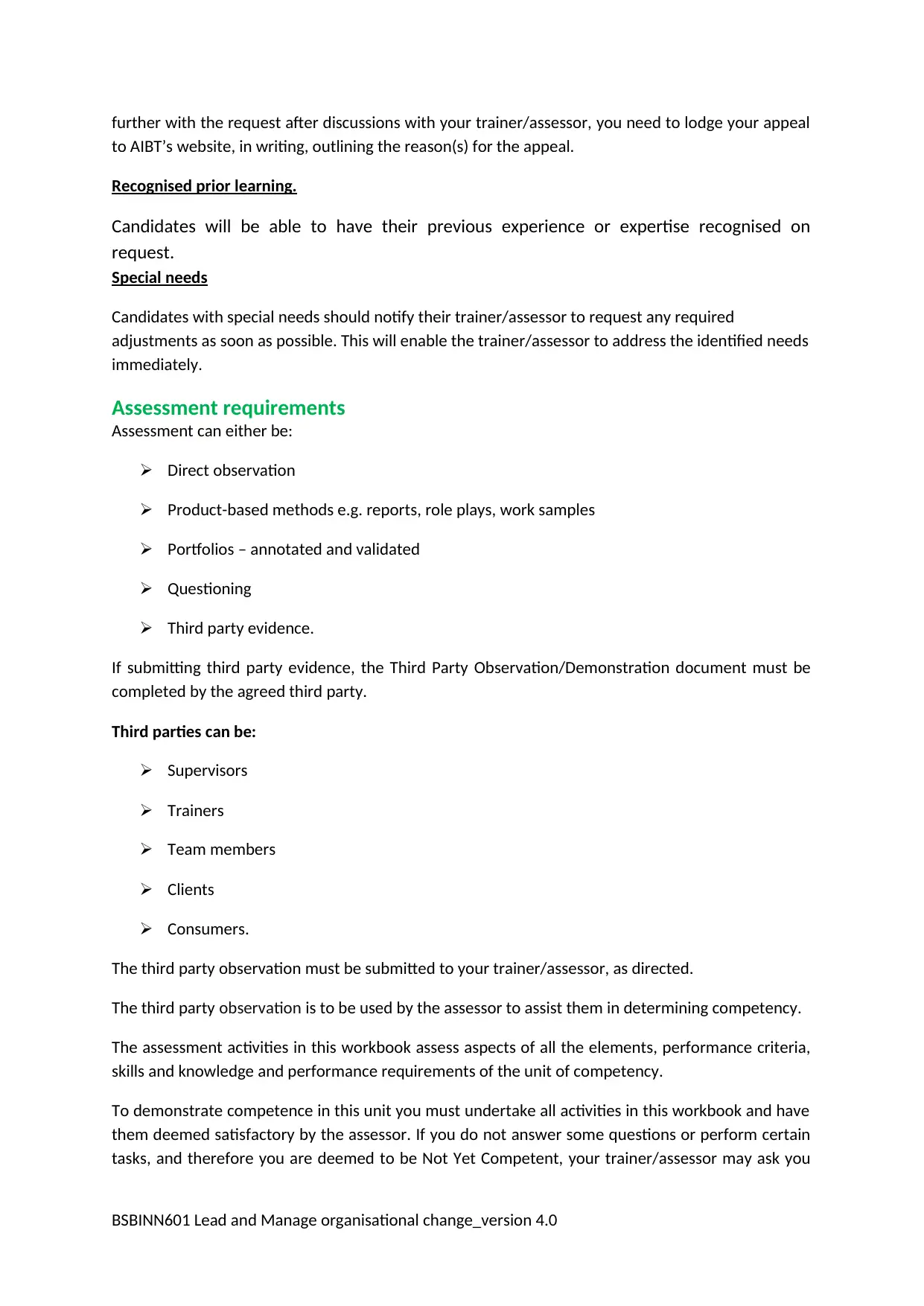
further with the request after discussions with your trainer/assessor, you need to lodge your appeal
to AIBT’s website, in writing, outlining the reason(s) for the appeal.
Recognised prior learning.
Candidates will be able to have their previous experience or expertise recognised on
request.
Special needs
Candidates with special needs should notify their trainer/assessor to request any required
adjustments as soon as possible. This will enable the trainer/assessor to address the identified needs
immediately .
Assessment requirements
Assessment can either be:
Direct observation
Product-based methods e.g. reports, role plays, work samples
Portfolios – annotated and validated
Questioning
Third party evidence.
If submitting third party evidence, the Third Party Observation/Demonstration document must be
completed by the agreed third party.
Third parties can be:
Supervisors
Trainers
Team members
Clients
Consumers.
The third party observation must be submitted to your trainer/assessor, as directed.
The third party observation is to be used by the assessor to assist them in determining competency.
The assessment activities in this workbook assess aspects of all the elements, performance criteria,
skills and knowledge and performance requirements of the unit of competency.
To demonstrate competence in this unit you must undertake all activities in this workbook and have
them deemed satisfactory by the assessor. If you do not answer some questions or perform certain
tasks, and therefore you are deemed to be Not Yet Competent, your trainer/assessor may ask you
BSBINN601 Lead and Manage organisational change_version 4.0
to AIBT’s website, in writing, outlining the reason(s) for the appeal.
Recognised prior learning.
Candidates will be able to have their previous experience or expertise recognised on
request.
Special needs
Candidates with special needs should notify their trainer/assessor to request any required
adjustments as soon as possible. This will enable the trainer/assessor to address the identified needs
immediately .
Assessment requirements
Assessment can either be:
Direct observation
Product-based methods e.g. reports, role plays, work samples
Portfolios – annotated and validated
Questioning
Third party evidence.
If submitting third party evidence, the Third Party Observation/Demonstration document must be
completed by the agreed third party.
Third parties can be:
Supervisors
Trainers
Team members
Clients
Consumers.
The third party observation must be submitted to your trainer/assessor, as directed.
The third party observation is to be used by the assessor to assist them in determining competency.
The assessment activities in this workbook assess aspects of all the elements, performance criteria,
skills and knowledge and performance requirements of the unit of competency.
To demonstrate competence in this unit you must undertake all activities in this workbook and have
them deemed satisfactory by the assessor. If you do not answer some questions or perform certain
tasks, and therefore you are deemed to be Not Yet Competent, your trainer/assessor may ask you
BSBINN601 Lead and Manage organisational change_version 4.0

supplementary questions to determine your competence. Once you have demonstrated the
required level of performance, you will be deemed competent in this unit.
Should you still be deemed Not Yet Competent, you will have the opportunity to resubmit your
assessments or appeal the result.
As part of the assessment process, all learners must abide by any relevant assessment policies as
provided during induction. If you feel you are not yet ready to be assessed or that this assessment is
unfair, please contact your assessor to discuss your options. You have the right to formally appeal
any outcome and, if you wish to do so, discuss this with your trainer/assessor
BSBINN601 Lead and Manage organisational change_version 4.0
required level of performance, you will be deemed competent in this unit.
Should you still be deemed Not Yet Competent, you will have the opportunity to resubmit your
assessments or appeal the result.
As part of the assessment process, all learners must abide by any relevant assessment policies as
provided during induction. If you feel you are not yet ready to be assessed or that this assessment is
unfair, please contact your assessor to discuss your options. You have the right to formally appeal
any outcome and, if you wish to do so, discuss this with your trainer/assessor
BSBINN601 Lead and Manage organisational change_version 4.0
⊘ This is a preview!⊘
Do you want full access?
Subscribe today to unlock all pages.

Trusted by 1+ million students worldwide
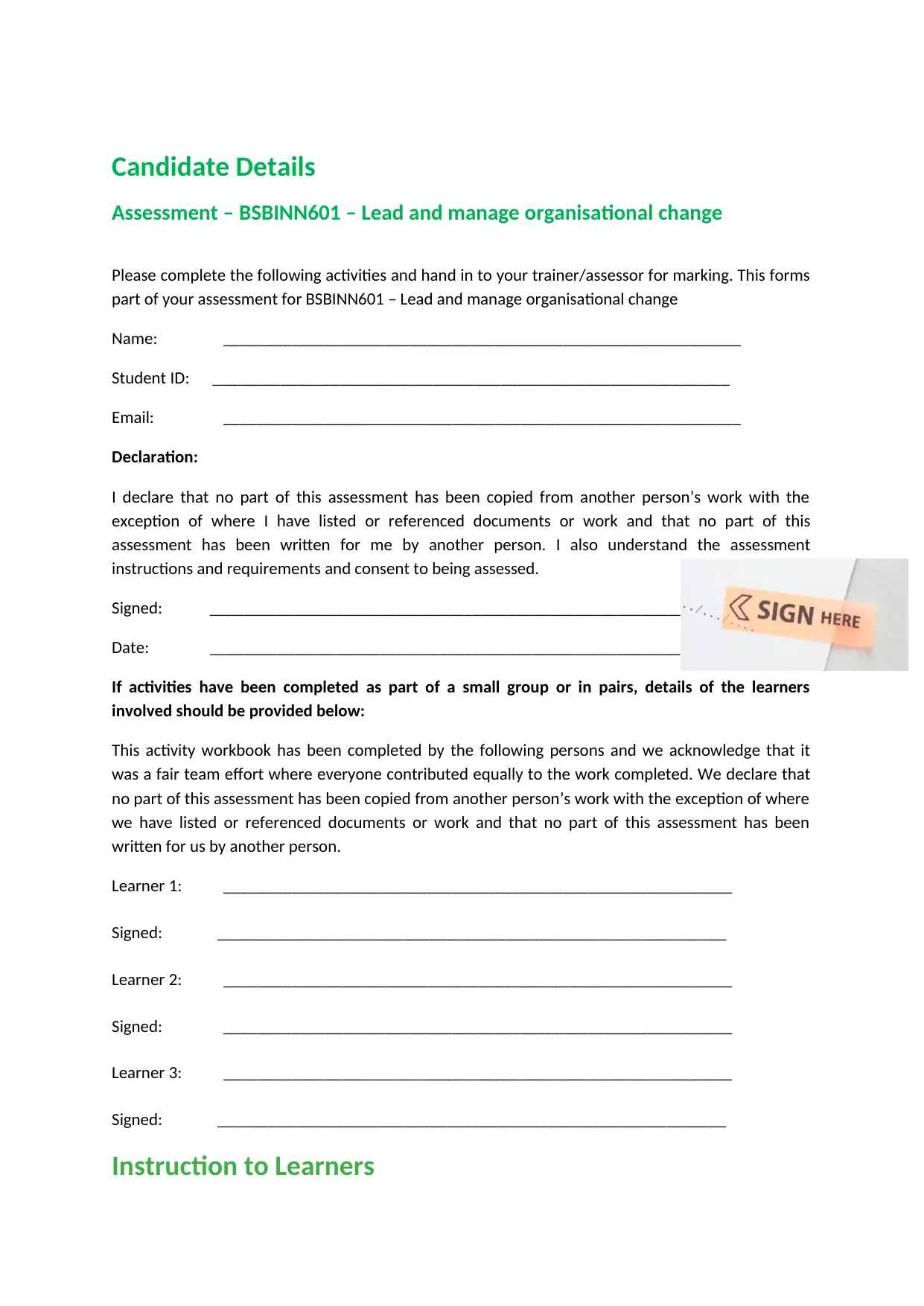
Candidate Details
Assessment – BSBINN601 – Lead and manage organisational change
Please complete the following activities and hand in to your trainer/assessor for marking. This forms
part of your assessment for BSBINN601 – Lead and manage organisational change
Name: _____________________________________________________________
Student ID: _____________________________________________________________
Email: _____________________________________________________________
Declaration:
I declare that no part of this assessment has been copied from another person’s work with the
exception of where I have listed or referenced documents or work and that no part of this
assessment has been written for me by another person. I also understand the assessment
instructions and requirements and consent to being assessed.
Signed: ____________________________________________________________
Date: ____________________________________________________________
If activities have been completed as part of a small group or in pairs, details of the learners
involved should be provided below:
This activity workbook has been completed by the following persons and we acknowledge that it
was a fair team effort where everyone contributed equally to the work completed. We declare that
no part of this assessment has been copied from another person’s work with the exception of where
we have listed or referenced documents or work and that no part of this assessment has been
written for us by another person.
Learner 1: ____________________________________________________________
Signed: ____________________________________________________________
Learner 2: ____________________________________________________________
Signed: ____________________________________________________________
Learner 3: ____________________________________________________________
Signed: ____________________________________________________________
Instruction to Learners
Assessment – BSBINN601 – Lead and manage organisational change
Please complete the following activities and hand in to your trainer/assessor for marking. This forms
part of your assessment for BSBINN601 – Lead and manage organisational change
Name: _____________________________________________________________
Student ID: _____________________________________________________________
Email: _____________________________________________________________
Declaration:
I declare that no part of this assessment has been copied from another person’s work with the
exception of where I have listed or referenced documents or work and that no part of this
assessment has been written for me by another person. I also understand the assessment
instructions and requirements and consent to being assessed.
Signed: ____________________________________________________________
Date: ____________________________________________________________
If activities have been completed as part of a small group or in pairs, details of the learners
involved should be provided below:
This activity workbook has been completed by the following persons and we acknowledge that it
was a fair team effort where everyone contributed equally to the work completed. We declare that
no part of this assessment has been copied from another person’s work with the exception of where
we have listed or referenced documents or work and that no part of this assessment has been
written for us by another person.
Learner 1: ____________________________________________________________
Signed: ____________________________________________________________
Learner 2: ____________________________________________________________
Signed: ____________________________________________________________
Learner 3: ____________________________________________________________
Signed: ____________________________________________________________
Instruction to Learners
Paraphrase This Document
Need a fresh take? Get an instant paraphrase of this document with our AI Paraphraser
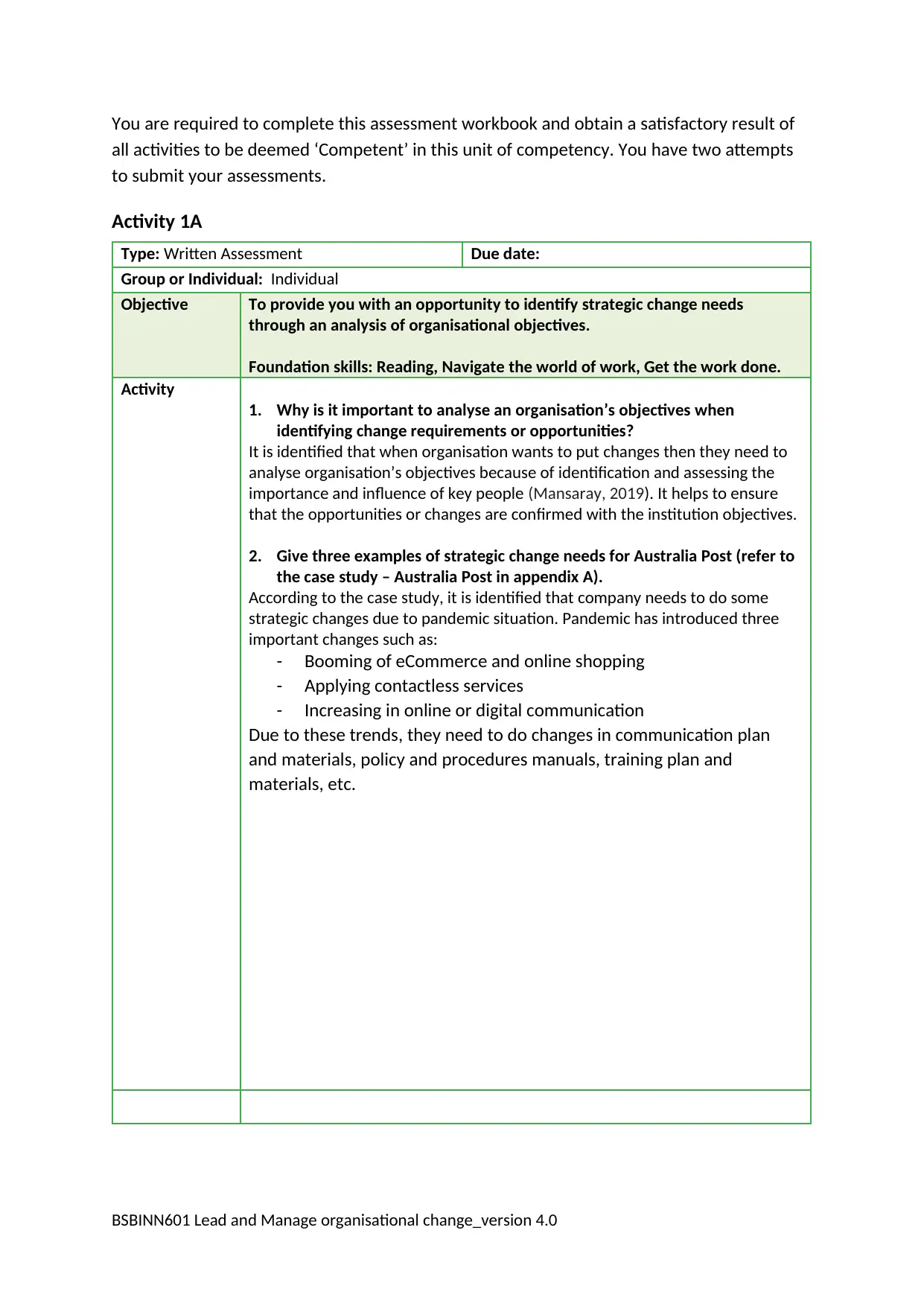
You are required to complete this assessment workbook and obtain a satisfactory result of
all activities to be deemed ‘Competent’ in this unit of competency. You have two attempts
to submit your assessments.
Activity 1A
Type: Written Assessment Due date:
Group or Individual: Individual
Objective To provide you with an opportunity to identify strategic change needs
through an analysis of organisational objectives.
Foundation skills: Reading, Navigate the world of work, Get the work done.
Activity
1. Why is it important to analyse an organisation’s objectives when
identifying change requirements or opportunities?
It is identified that when organisation wants to put changes then they need to
analyse organisation’s objectives because of identification and assessing the
importance and influence of key people (Mansaray, 2019). It helps to ensure
that the opportunities or changes are confirmed with the institution objectives.
2. Give three examples of strategic change needs for Australia Post (refer to
the case study – Australia Post in appendix A).
According to the case study, it is identified that company needs to do some
strategic changes due to pandemic situation. Pandemic has introduced three
important changes such as:
- Booming of eCommerce and online shopping
- Applying contactless services
- Increasing in online or digital communication
Due to these trends, they need to do changes in communication plan
and materials, policy and procedures manuals, training plan and
materials, etc.
BSBINN601 Lead and Manage organisational change_version 4.0
all activities to be deemed ‘Competent’ in this unit of competency. You have two attempts
to submit your assessments.
Activity 1A
Type: Written Assessment Due date:
Group or Individual: Individual
Objective To provide you with an opportunity to identify strategic change needs
through an analysis of organisational objectives.
Foundation skills: Reading, Navigate the world of work, Get the work done.
Activity
1. Why is it important to analyse an organisation’s objectives when
identifying change requirements or opportunities?
It is identified that when organisation wants to put changes then they need to
analyse organisation’s objectives because of identification and assessing the
importance and influence of key people (Mansaray, 2019). It helps to ensure
that the opportunities or changes are confirmed with the institution objectives.
2. Give three examples of strategic change needs for Australia Post (refer to
the case study – Australia Post in appendix A).
According to the case study, it is identified that company needs to do some
strategic changes due to pandemic situation. Pandemic has introduced three
important changes such as:
- Booming of eCommerce and online shopping
- Applying contactless services
- Increasing in online or digital communication
Due to these trends, they need to do changes in communication plan
and materials, policy and procedures manuals, training plan and
materials, etc.
BSBINN601 Lead and Manage organisational change_version 4.0
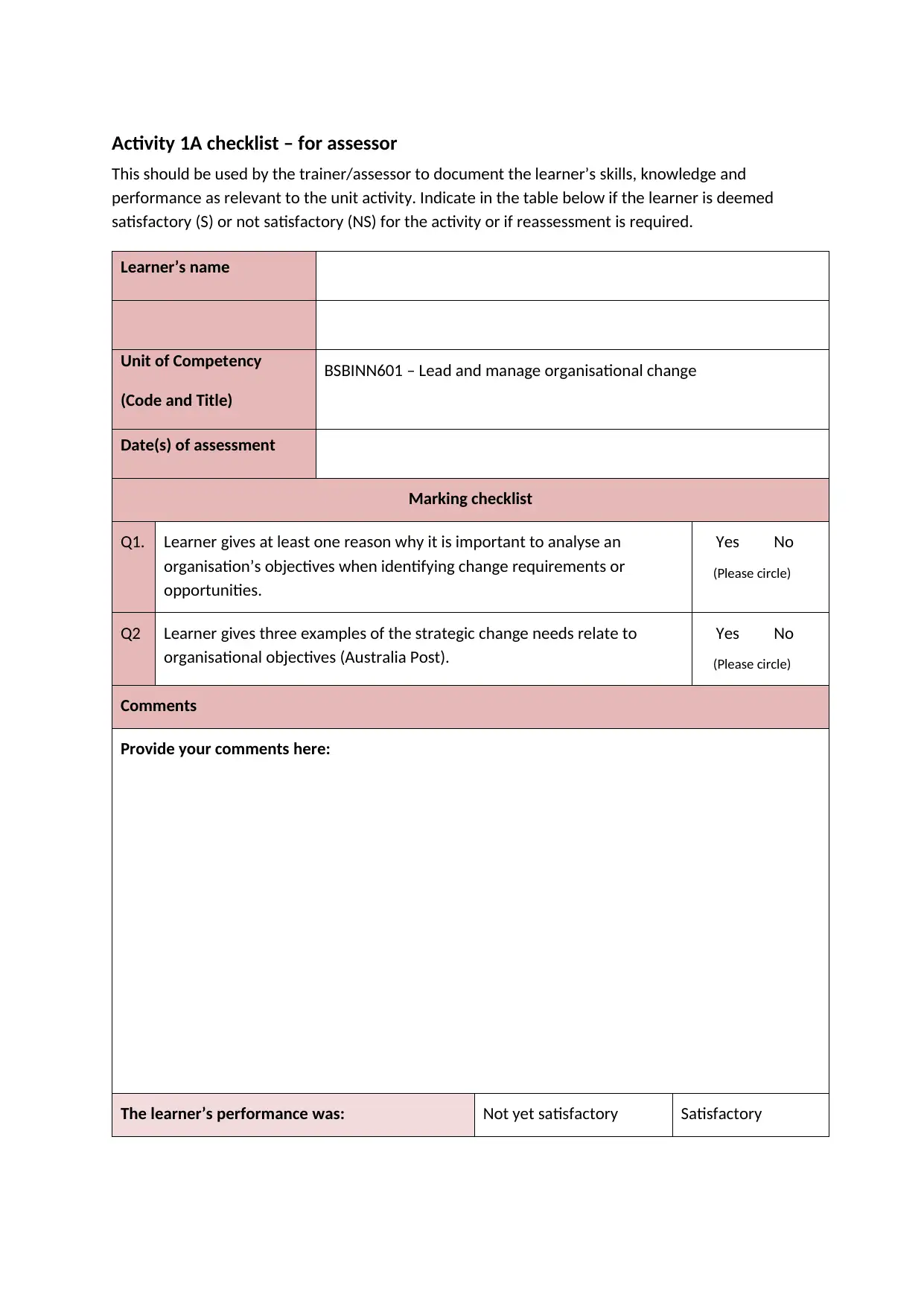
Activity 1A checklist – for assessor
This should be used by the trainer/assessor to document the learner’s skills, knowledge and
performance as relevant to the unit activity. Indicate in the table below if the learner is deemed
satisfactory (S) or not satisfactory (NS) for the activity or if reassessment is required.
Learner’s name
Unit of Competency
(Code and Title)
BSBINN601 – Lead and manage organisational change
Date(s) of assessment
Marking checklist
Q1. Learner gives at least one reason why it is important to analyse an
organisation’s objectives when identifying change requirements or
opportunities.
Yes No
(Please circle)
Q2 Learner gives three examples of the strategic change needs relate to
organisational objectives (Australia Post).
Yes No
(Please circle)
Comments
Provide your comments here:
The learner’s performance was: Not yet satisfactory Satisfactory
This should be used by the trainer/assessor to document the learner’s skills, knowledge and
performance as relevant to the unit activity. Indicate in the table below if the learner is deemed
satisfactory (S) or not satisfactory (NS) for the activity or if reassessment is required.
Learner’s name
Unit of Competency
(Code and Title)
BSBINN601 – Lead and manage organisational change
Date(s) of assessment
Marking checklist
Q1. Learner gives at least one reason why it is important to analyse an
organisation’s objectives when identifying change requirements or
opportunities.
Yes No
(Please circle)
Q2 Learner gives three examples of the strategic change needs relate to
organisational objectives (Australia Post).
Yes No
(Please circle)
Comments
Provide your comments here:
The learner’s performance was: Not yet satisfactory Satisfactory
⊘ This is a preview!⊘
Do you want full access?
Subscribe today to unlock all pages.

Trusted by 1+ million students worldwide
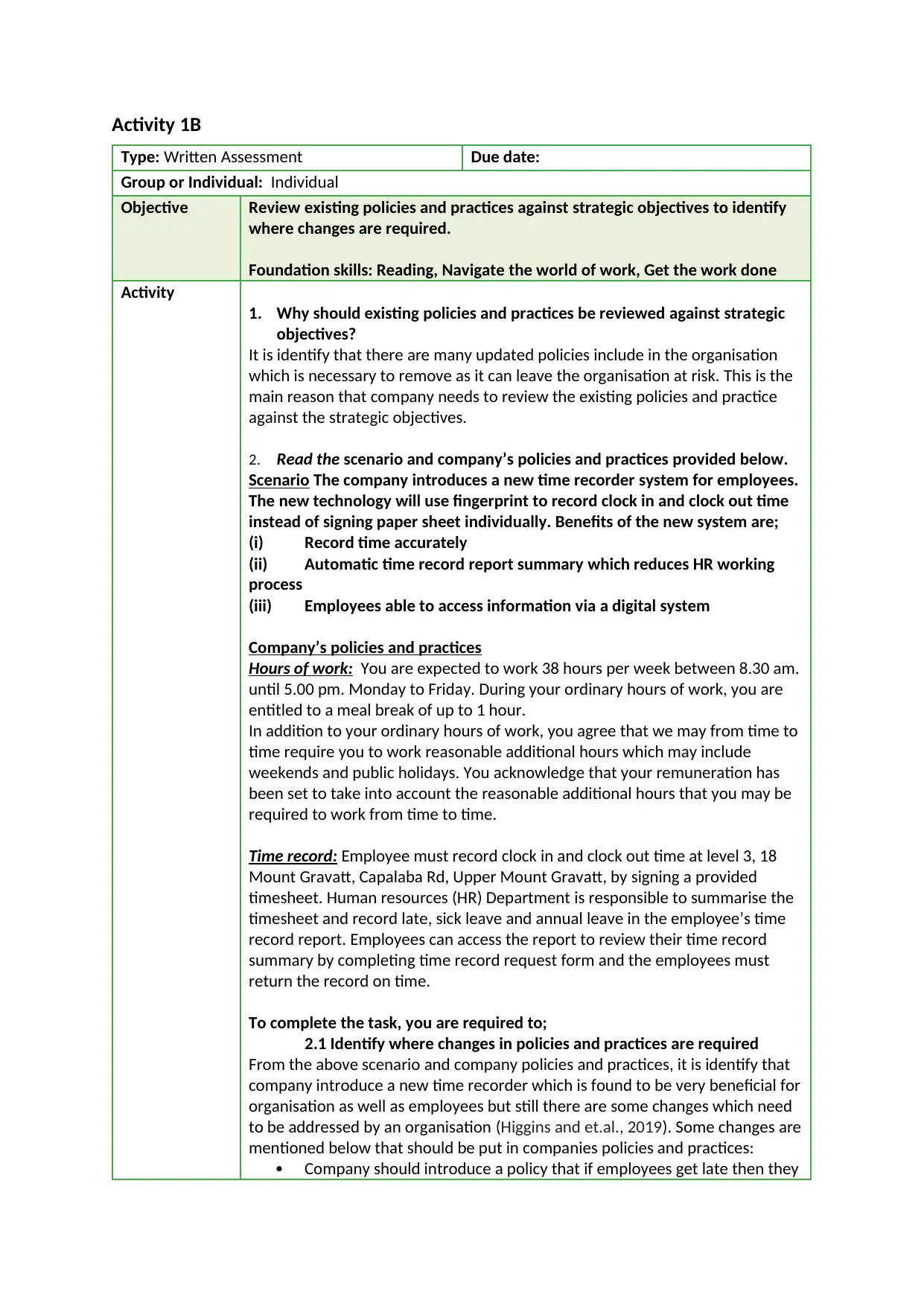
Activity 1B
Type: Written Assessment Due date:
Group or Individual: Individual
Objective Review existing policies and practices against strategic objectives to identify
where changes are required.
Foundation skills: Reading, Navigate the world of work, Get the work done
Activity
1. Why should existing policies and practices be reviewed against strategic
objectives?
It is identify that there are many updated policies include in the organisation
which is necessary to remove as it can leave the organisation at risk. This is the
main reason that company needs to review the existing policies and practice
against the strategic objectives.
2. Read the scenario and company’s policies and practices provided below.
Scenario The company introduces a new time recorder system for employees.
The new technology will use fingerprint to record clock in and clock out time
instead of signing paper sheet individually. Benefits of the new system are;
(i) Record time accurately
(ii) Automatic time record report summary which reduces HR working
process
(iii) Employees able to access information via a digital system
Company’s policies and practices
Hours of work: You are expected to work 38 hours per week between 8.30 am.
until 5.00 pm. Monday to Friday. During your ordinary hours of work, you are
entitled to a meal break of up to 1 hour.
In addition to your ordinary hours of work, you agree that we may from time to
time require you to work reasonable additional hours which may include
weekends and public holidays. You acknowledge that your remuneration has
been set to take into account the reasonable additional hours that you may be
required to work from time to time.
Time record: Employee must record clock in and clock out time at level 3, 18
Mount Gravatt, Capalaba Rd, Upper Mount Gravatt, by signing a provided
timesheet. Human resources (HR) Department is responsible to summarise the
timesheet and record late, sick leave and annual leave in the employee’s time
record report. Employees can access the report to review their time record
summary by completing time record request form and the employees must
return the record on time.
To complete the task, you are required to;
2.1 Identify where changes in policies and practices are required
From the above scenario and company policies and practices, it is identify that
company introduce a new time recorder which is found to be very beneficial for
organisation as well as employees but still there are some changes which need
to be addressed by an organisation (Higgins and et.al., 2019). Some changes are
mentioned below that should be put in companies policies and practices:
Company should introduce a policy that if employees get late then they
Type: Written Assessment Due date:
Group or Individual: Individual
Objective Review existing policies and practices against strategic objectives to identify
where changes are required.
Foundation skills: Reading, Navigate the world of work, Get the work done
Activity
1. Why should existing policies and practices be reviewed against strategic
objectives?
It is identify that there are many updated policies include in the organisation
which is necessary to remove as it can leave the organisation at risk. This is the
main reason that company needs to review the existing policies and practice
against the strategic objectives.
2. Read the scenario and company’s policies and practices provided below.
Scenario The company introduces a new time recorder system for employees.
The new technology will use fingerprint to record clock in and clock out time
instead of signing paper sheet individually. Benefits of the new system are;
(i) Record time accurately
(ii) Automatic time record report summary which reduces HR working
process
(iii) Employees able to access information via a digital system
Company’s policies and practices
Hours of work: You are expected to work 38 hours per week between 8.30 am.
until 5.00 pm. Monday to Friday. During your ordinary hours of work, you are
entitled to a meal break of up to 1 hour.
In addition to your ordinary hours of work, you agree that we may from time to
time require you to work reasonable additional hours which may include
weekends and public holidays. You acknowledge that your remuneration has
been set to take into account the reasonable additional hours that you may be
required to work from time to time.
Time record: Employee must record clock in and clock out time at level 3, 18
Mount Gravatt, Capalaba Rd, Upper Mount Gravatt, by signing a provided
timesheet. Human resources (HR) Department is responsible to summarise the
timesheet and record late, sick leave and annual leave in the employee’s time
record report. Employees can access the report to review their time record
summary by completing time record request form and the employees must
return the record on time.
To complete the task, you are required to;
2.1 Identify where changes in policies and practices are required
From the above scenario and company policies and practices, it is identify that
company introduce a new time recorder which is found to be very beneficial for
organisation as well as employees but still there are some changes which need
to be addressed by an organisation (Higgins and et.al., 2019). Some changes are
mentioned below that should be put in companies policies and practices:
Company should introduce a policy that if employees get late then they
Paraphrase This Document
Need a fresh take? Get an instant paraphrase of this document with our AI Paraphraser

will have to work extra hours.
They also need to make a policy that the late working of an employee is
continue about 7 days then it should be give penalty for the reason.
2.2 Adjust company’s policies in accordance with the change
It is necessary for an organisation to make a policy that they need to
check the performance and timing of an individual on a weekly basis.
They also need to make a policy for their performances and
punctuality.
BSBINN601 Lead and Manage organisational change_version 4.0
They also need to make a policy that the late working of an employee is
continue about 7 days then it should be give penalty for the reason.
2.2 Adjust company’s policies in accordance with the change
It is necessary for an organisation to make a policy that they need to
check the performance and timing of an individual on a weekly basis.
They also need to make a policy for their performances and
punctuality.
BSBINN601 Lead and Manage organisational change_version 4.0
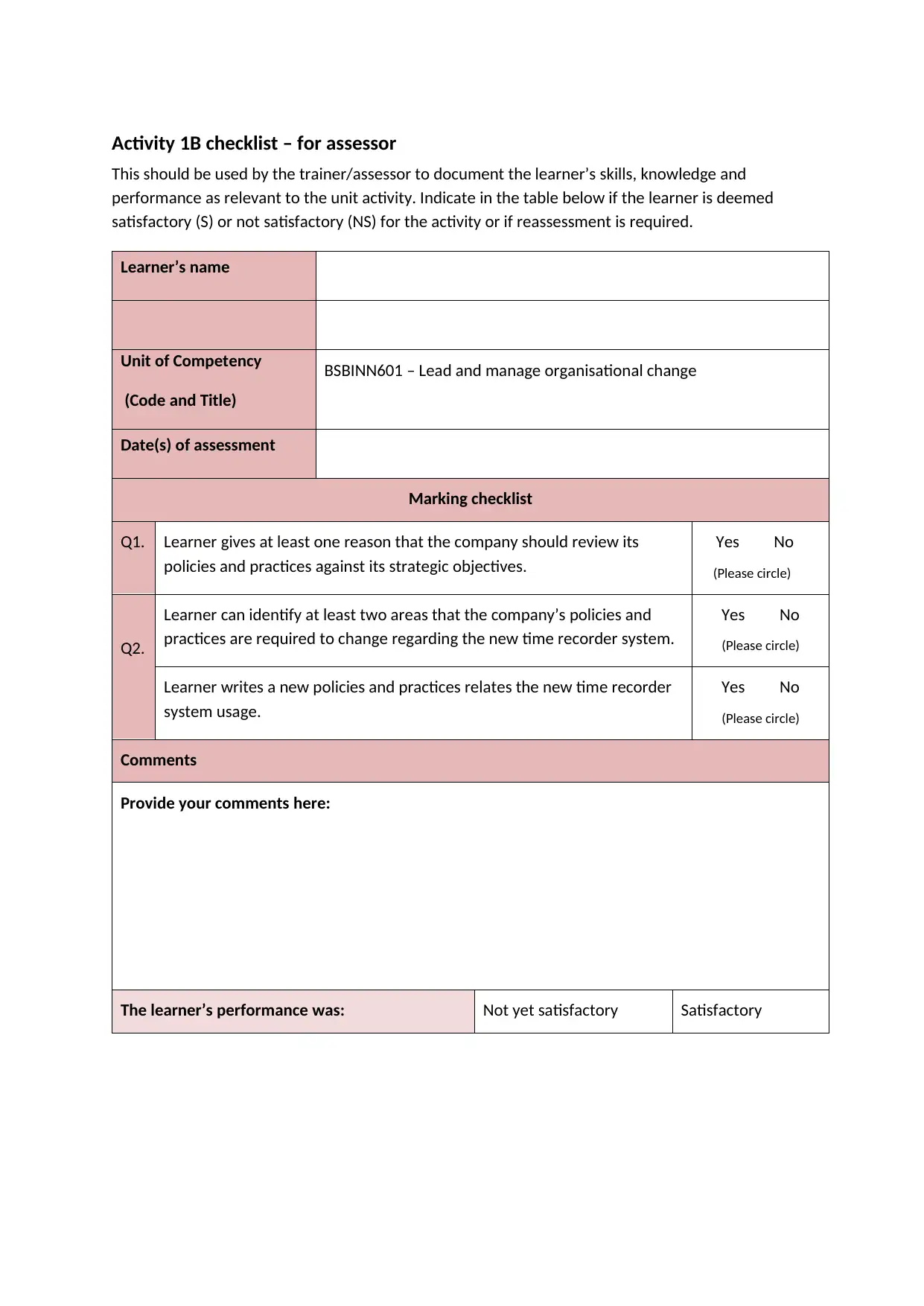
Activity 1B checklist – for assessor
This should be used by the trainer/assessor to document the learner’s skills, knowledge and
performance as relevant to the unit activity. Indicate in the table below if the learner is deemed
satisfactory (S) or not satisfactory (NS) for the activity or if reassessment is required.
Learner’s name
Unit of Competency
(Code and Title)
BSBINN601 – Lead and manage organisational change
Date(s) of assessment
Marking checklist
Q1. Learner gives at least one reason that the company should review its
policies and practices against its strategic objectives.
Yes No
(Please circle)
Q2.
Learner can identify at least two areas that the company’s policies and
practices are required to change regarding the new time recorder system.
Yes No
(Please circle)
Learner writes a new policies and practices relates the new time recorder
system usage.
Yes No
(Please circle)
Comments
Provide your comments here:
The learner’s performance was: Not yet satisfactory Satisfactory
This should be used by the trainer/assessor to document the learner’s skills, knowledge and
performance as relevant to the unit activity. Indicate in the table below if the learner is deemed
satisfactory (S) or not satisfactory (NS) for the activity or if reassessment is required.
Learner’s name
Unit of Competency
(Code and Title)
BSBINN601 – Lead and manage organisational change
Date(s) of assessment
Marking checklist
Q1. Learner gives at least one reason that the company should review its
policies and practices against its strategic objectives.
Yes No
(Please circle)
Q2.
Learner can identify at least two areas that the company’s policies and
practices are required to change regarding the new time recorder system.
Yes No
(Please circle)
Learner writes a new policies and practices relates the new time recorder
system usage.
Yes No
(Please circle)
Comments
Provide your comments here:
The learner’s performance was: Not yet satisfactory Satisfactory
⊘ This is a preview!⊘
Do you want full access?
Subscribe today to unlock all pages.

Trusted by 1+ million students worldwide
1 out of 57
Related Documents
Your All-in-One AI-Powered Toolkit for Academic Success.
+13062052269
info@desklib.com
Available 24*7 on WhatsApp / Email
![[object Object]](/_next/static/media/star-bottom.7253800d.svg)
Unlock your academic potential
Copyright © 2020–2025 A2Z Services. All Rights Reserved. Developed and managed by ZUCOL.



